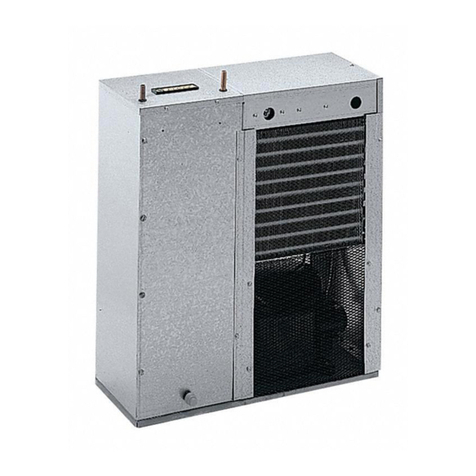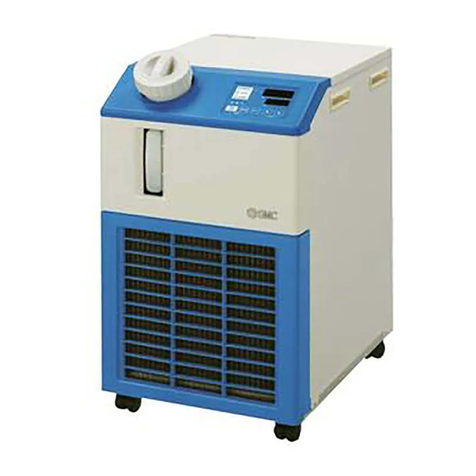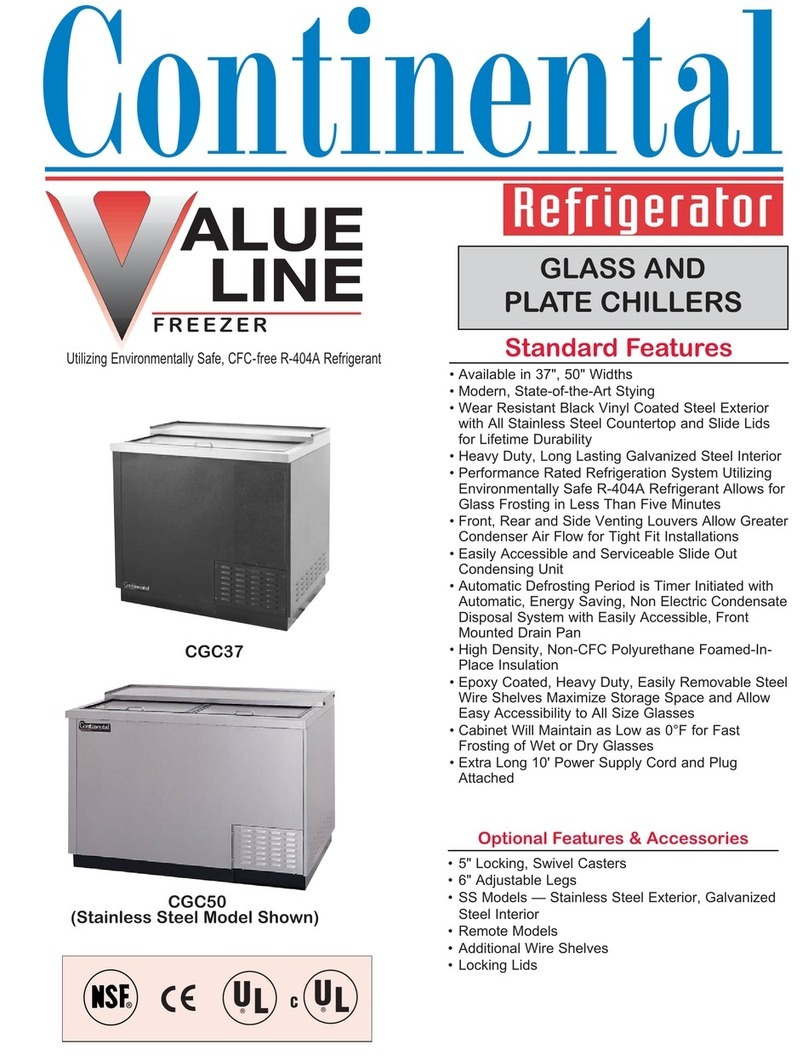United Technologies Carrier Touchpilot 30XW-V Manual

INSTALLATION, OPERATION AND
MAINTENANCE INSTRUCTIONS
Variable-Speed Water-Cooled Liquid Chillers/
Variable-Speed Water-to-Water Heat Pumps
30XW-V/30XWHV
Nominal cooling capacity: 587-1741 kW
Nominal heating capacity: 648-1932 kW
50 Hz
Original instructions

2
CONTENTS
1 - INTRODUCTION ..................................................................................................................................................................... 4
1.1 - Installation safety considerations ........................................................................................................................................... 4
1.2 - Equipment and components under pressure ........................................................................................................................ 5
1.3 - Maintenance safety considerations ........................................................................................................................................ 5
1.4 - Repair safety considerations................................................................................................................................................... 7
2 - PRELIMINARY CHECKS ...................................................................................................................................................... 9
2.1 - Check equipment received...................................................................................................................................................... 9
2.2 - Moving and siting the unit....................................................................................................................................................... 9
3 - DIMENSIONS, CLEARANCES........................................................................................................................................... 10
4 - PHYSICAL AND ELECTRICAL DATA............................................................................................................................ 12
4.1 - Physical data ........................................................................................................................................................................... 12
4.2 - Electrical data......................................................................................................................................................................... 13
4.3 - Short-circuit stability current for all units ........................................................................................................................... 14
4.4 - Compressor electrical data.................................................................................................................................................... 14
4.5 - Compressor usage .................................................................................................................................................................. 14
5 - ELECTRICAL CONNECTION............................................................................................................................................ 15
5.1 - Power supply........................................................................................................................................................................... 15
5.2 - Voltage phase imbalance (%) ............................................................................................................................................... 15
5.3 - Power connection/disconnect switch.................................................................................................................................... 15
5.4 - Recommended wire sections ................................................................................................................................................ 15
5.5 - Power cable entry................................................................................................................................................................... 15
5.6 - Field control wiring ................................................................................................................................................................ 16
5.7 - 24 and 230 V power reserve for the user ............................................................................................................................. 16
6 - APPLICATION DATA ........................................................................................................................................................... 16
6.1 - Operating limits...................................................................................................................................................................... 16
6.2 - Condenser-side installation recommendation .................................................................................................................... 16
6.3 - Minimum chilled water ow ................................................................................................................................................. 17
6.4 - Maximum chilled water ow................................................................................................................................................. 17
6.5 - Condenser water ow rate ................................................................................................................................................... 17
6.6 - Number of passes .................................................................................................................................................................. 17
6.7 - Evaporator and condenser water ow rates ....................................................................................................................... 17
6.8 - Minimum temperature difference........................................................................................................................................ 18
6.9 - Variable ow evaporator ....................................................................................................................................................... 18
6.10 - System minimum water volume ......................................................................................................................................... 18
6.11 - Pressure drop curves............................................................................................................................................................ 19
7 - WATER CONNECTIONS...................................................................................................................................................... 19
7.1 - Operating precautions ........................................................................................................................................................... 19
7.2 - Water connections .................................................................................................................................................................. 20
7.3 - Flow control ............................................................................................................................................................................ 21
7.4 - Evaporator and condenser water box bolt tightening ....................................................................................................... 21
7.5 - Operation of two units in master/slave mode ..................................................................................................................... 21
8 - HEAT PUMPS 30XWHV ....................................................................................................................................................... 22
8.1 - Physical data for heat pumps ................................................................................................................................................ 22
8.2 - Electrical data for heat pumps.............................................................................................................................................. 22
8.3 - Dimensions and clearances for heat pumps .......................................................................................................................... 22
8.4 - Operating range for heat pumps .......................................................................................................................................... 22
8.5 - Operating modes for heat pumps......................................................................................................................................... 22

3
The cover photograph is for illustrative purposes only and is not part of any offer for sale or contract.
This manual applies to the following two variable-speed 30XW unit types:
• 30XW-V Liquid chillers
• 30XWHV Heat pumps
For the operation of the control please refer to the Touch Pilot control manual.
9 - MAJOR SYSTEM COMPONENTS AND OPERATION DATA ..................................................................................... 22
9.1 - Compressors............................................................................................................................................................................ 22
9.2 - Oil lter ................................................................................................................................................................................... 22
9.3 - Refrigerant.............................................................................................................................................................................. 22
9.4 - Lubricant ................................................................................................................................................................................. 22
9.5 - Oil supply solenoid valve.......................................................................................................................................................22
9.6 - Pressure vessels....................................................................................................................................................................... 22
9.7 - High-pressure safety switch .................................................................................................................................................. 23
9.8 - Electronic expansion valve (EXV) ...................................................................................................................................... 23
9.9 - Moisture indicator.................................................................................................................................................................. 23
9.10 - Filter drier ............................................................................................................................................................................. 23
9.11 - Sensors................................................................................................................................................................................... 23
9.12 - Frequency variator ............................................................................................................................................................... 23
10 - OPTIONS ................................................................................................................................................................................ 24
11 - STANDARD MAINTENANCE.......................................................................................................................................... 25
11.1 - Level 1 maintenance ............................................................................................................................................................ 25
11.2 - Level 2 maintenance ............................................................................................................................................................ 25
11.3 - Level 3 (or higher) maintenance ........................................................................................................................................ 25
11.4 - Tightening of the electrical connections ............................................................................................................................ 25
11.5 - Tightening torques for the main bolts and screws ............................................................................................................ 26
11.6 - Evaporator and condenser maintenance........................................................................................................................... 26
11.7 - Compressor maintenance.................................................................................................................................................... 26
11.8 - Frequency variator maintenance........................................................................................................................................ 27
11.9 - Service valve (option 92)..................................................................................................................................................... 27
12 - START-UP CHECKLIST FOR 30XW-V/30XWHV UNITS (USE FOR JOB FILE) ................................................ 28

4
30XW-V/30XWHV units are designed to cool or heat water
for the air conditioning and heating of buildings and
industrial procsses.
Prior to the initial start-up of the 30XW-V/30XWHV units,
the people involved in the on-site installation, start-up,
operation, and maintenance of this unit should be thoroughly
familiar with these instructions and the specic project
data for the installation site.
30XW-V/30XWHV units are designed for a very high level of
safety during installation, start-up, operation and maintenance.
They are designed for an operating life of 15 years by
assuming a 75% utilisation factor; that is approximately
100,000 operating hours.
They will provide safe and long-lasting service when operated
within their application range.
This manual provides the necessary information to fami-
liarize yourself with the control system before performing
start-up procedures. The procedures in this manual are
arranged in the sequence required for machine installation,
start-up, operation and maintenance.
Always ensure that all required safety measures are followed,
including those in this document, such as: wearing protec-
tive clothing (gloves, ear defenders, safety glasses and shoes)
using appropriate tools, employing qualied and skilled
technicians (electricians, refrigeration engineers) and
following local regulations.
To nd out, if these products comply with European
directives (machine safety, low voltage, electromagnetic
compatibility, equipment under pressure etc.) check the
declarations of conformity for these products.
1.1 - Installation safety considerations
Access to the unit must be reserved to authorised personnel,
qualied and trained in monitoring and maintenance. The
access limitation device must be installed by the customer
(e.g. cut-off, enclosure).
After the unit has been received and is ready to be installed
or reinstalled and before it is started up, it must be inspected
for damage. Check that the refrigerant circuit(s) is (are)
intact, especially that no components or pipes have shifted
(e.g. following a shock). If in doubt, carry out a leak tightness
check and verify with the manufacturer that the circuit
integrity has not been impaired. If damage is detected upon
receipt, immediately le a claim with the shipping company.
Carrier strongly recommends employing a specialised
company to unload the machine.
It is compulsory to wear personal protection equipment.
Do not remove the skid or the packaging until the unit is
in its nal position. These units can be moved with a fork
lift truck, as long as the forks are positioned in the right
place and direction on the unit.
The units can also be lifted with slings, using only the
designated lifting points marked on the unit.
Use slings or lifting beams with the correct capacity, and
always follow the lifting instructions on the certied
drawings supplied with the unit. Do not tilt the unit more
than 15°.
Safety is only guaranteed, if these instructions are carefully
followed. If this is not the case, there is a risk of material
deterioration and injuries to personnel.
Never cover any protection devices.
This applies to the relief valves (if used) in the refrigerant
or heat transfer medium circuits, the fuse plugs and the
pressure switches.
Ensure that the valves are correctly installed, before
operating the unit.
Classication and control
In accordance with the Pressure Equipment Directive and
national usage monitoring regulations in the European
Union the protection devices for these machines are
classied as follows:
Safety
accessory*
Damage limitation accessory**
Refrigerant side
High-pressure switch x
External relief valve*** x
Rupture disk x
Fuse plug x
External relief valve**** x
* Classiedforprotectioninnormalservicesituations.
** Classiedforprotectioninabnormalservicesituations.
*** The instantaneous over-pressure limited to 10% of the operating pressure
doesnotapplytothisabnormalservicesituation.Thecontrolpressurecanbe
higherthantheservicepressure.Inthiscaseeitherthedesigntemperatureor
the high-pressure switch ensures that the service pressure is not exceeded in
normalservicesituations.
**** Theclassicationofthesereliefvalvesmustbemadebythepersonnelthat
completesthewholehydronicinstallation.
If the relief valves are installed on a change-over manifold,
this is equipped with a relief valve on each of the two
outlets. Only one of the two relief valves is in operation,
the other one is isolated. Never leave the change-over
valve in the intermediate position, i.e. with both ways
open (locate the control element in the stop position). If a
relief valve is removed for checking or replacement please
ensure that there is always an active relief valve on each
of the change-over valves installed in the unit.
All factory-installed relief valves are lead-sealed to prevent
any calibration change.
The external relief valves and the fuses are designed and
installed to ensure damage limitation in case of a re.
In accordance with the regulations applied for the design,
the European directive on equipment under pressure and
in accordance with the national usage regulations:
• These relief valves and fuses are not safety accessories
but damage limitation accessories in case of a re,
• The high pressure switches are the safety accessories.

5
The relief valve must only be removed if the re risk is
fully controlled and after checking that this is allowed by
local regulations and authorities. This is the responsibility
of the operator.
When the unit is subjected to re, safety devices prevent
rupture due to over-pressure by releasing the refrigerant.
The uid may then be decomposed into toxic residues
when subjected to the ame:
- Stay away from the unit.
- Set up warnings and recommendations for personnel in
charge to stop the re.
- Fire extinguishers appropriate to the system and the
refrigerant type must be easily accessible.
The external relief valves must in principle be connected
to discharge pipes for units installed in a room. Refer to
the installation regulations, for example those of European
standards EN 378 and EN 13136.
They include a sizing method and examples for congura-
tion and calculation. Under certain conditions these stan-
dards permit connection of several valves to the same
discharge pipe. Note: Like all other standards these EN
standards are available from national standards organi-
sations.
These pipes must be installed in a way that ensures that
people and property are not exposed to refrigerant leaks.
These uids may be diffused in the air, but far away from
any building air intake, or they must be discharged in a
quantity that is appropriate for a suitably absorbing
environment.
It is recommended to install an indicating device to show
if part of the refrigerant has leaked from the valve. The
presence of oil at the outlet orice is a useful indicator
that refrigerant has leaked. Keep this orice clean to
ensure that any leaks are obvious.
The calibration of a valve that has leaked is generally
lower than its original calibration. The new calibration
may affect the operating range. To avoid a nuisance
tripping or leaks, replace or re-calibrate the valve.
Periodic check of the relief valves: See paragraph 1.3
“Maintenance safety considerations”.
Provide a drain in the discharge circuit, close to each
relief valve, to avoid an accumulation of condensate or
rain water.
All refrigerant handling precautions must comply with
local regulations.
Ensure good ventilation, as accumulation of refrigerant
in an enclosed space can displace oxygen and cause
asphyxiation or explosions.
Inhalation of high concentrations of vapour is harmful
and may cause heart irregularities, unconsciousness, or
death. Vapour is heavier than air and reduces the amount
of oxygen available for breathing. These products cause
eye and skin irritation. Decomposition products are
hazardous.
These products incorporate equipment or components under
pressure, manufactured by Carrier or other manufacturers.
We recommend that you consult your appropriate national
trade association or the owner of the equipment or compo-
nents under pressure (declaration, re-qualication, retesting,
etc.).The characteristics of this equipment/these components
are given on the nameplate or in the required documenta-
tion, supplied with the products.
The units are intended to be stored and operate in an
environment where the ambient temperature must not be
less than the lowest allowable temperature indicated on
the nameplate.
See section “9.6 - Pressure vessels”.
1.3 - Maintenance safety considerations
Carrier recommends the following drafting for a logbook
(the table below should not be considered as reference
and does not involve Carrier responsibility):
Intervention Name of the
commissioning
engineer
national
Organism
Date (1)
(1) Maintenance,repairs,regularverications(EN378),leakage,etc.
Engineers working on the electric or refrigeration compo-
nents must be authorized, trained and fully qualied to do so.
All refrigerant circuit repairs must be carried out by a trained
person, fully qualied to work on these units. He must have
been trained and be familiar with the equipment and the
installation. All welding operations must be carried out by
qualied specialists.
The insulation must be removed and heat generation must
be limited by using a wet cloth.
Any manipulation (opening or closing) of a shut-off valve
must be carried out by a qualied and authorised engineer.
These procedures must be carried out with the unit shut-
down.
NOTE: The unit must never be left shut down with the
liquid line valve closed, as liquid refrigerant can be trapped
between this valve and the expansion device. (This valve
is situated on the liquid line before the lter drier box.)
During any handling, maintenance and service operations
the engineers working on the unit must be equipped with
safety gloves, glasses, shoes and protective clothing.
Never work on a unit that is still energized.
Never work on any of the electrical components, until the
general power supply to the unit has been cut using the
disconnect switch(es) in the control box(es).

6
A logbook must be established for the systems that
require a tightness check. It should contain the
quantity and the type of uid present within the
installation (added and recovered), the quantity of
recycled uid, the date and output of the leak test, the
designation of the operator and its belonging
company, etc.
Leak test periodicity:
System WITHOUT
leakage detection
No check 12 months 6 months 3 months
System WITH
leakage detection
No check 24 months 12 months 6 months
CO2
tonnes < 5 5≤charge<50 50≤charge<500 charge > 500
Refrigerant
kg of
R134A
charge
<3.5
3.5≤charge
<34.9
34.9≤charge
<349.7
charge
>349.7
• During the life-time of the system, inspection and tests
must be carried out in accordance with national
regulations.
Protection device checks:
• If no national regulations exist, check the protection
devices on site in accordance with standard EN378:
once a year for the high-pressure switches, every ve
years for external relief valves.
• The detailed description of the high-pressure switch
test method is given in the service manual for the unit.
The company or organisation that conducts a pressure
switch test shall establish and implement a detailed
procedure to x:
- Safety measures
- Measuring equipment calibration
- Validating operation of protective devices
- Test protocols
- Recommissioning of the equipment.
Consult Carrier Service for this type of test. Carrier
mentions here only the principle of a test without
removing the pressure switch:
- Verify and and record the set-points of pressure
switches and relief devices (valves and possible
rupture discs)
- Be ready to switch-off the main disconnect switch
of the power supply if the pressure switch does
not trigger (avoid over-pressure or excess gas in
case of valves on the high-pressure side with the
recovery condensers)
- Connect a calibrated pressure gauge (the values
displayed on the user interface may be inaccurate
in an instant reading because of the scanning
delay applied in the control)
- Neutralise the HP soft value
- Cut the condenser water ow
- Check the cut-off value
- Reactivate HP soft value
- Reactivate manually HP switch.
CAUTION: If the test leads to replacing the pressure
switch, it is necessary to recover the refrigerant charge,
these pressure switches are not installed on automatic
valves (Schraeder type).
If any maintenance operations are carried out on the unit,
lock the power supply circuit in the open position ahead
of the machine.
ATTENTION: The frequency variators used in the
30XW-V/30XWHV units are equipped with capacitor
batteries with a discharge time of twenty (20) minutes
after disconnecting the power.
After disconnecting the power to the control box, wait
twenty minutes before openeing the control box.
Before any intervention, verify that there is no voltage
present at any accessible conducting parts of the power
circuit.
If the work is interrupted, always ensure that all circuits
are still deenergized before resuming the work.
ATTENTION: Even if the unit has been switched off, the
power circuit remains energized, unless the unit or circuit
disconnect switch is open. Refer to the wiring diagram for
further details. Attach appropriate safety labels.
Operating checks:
IMPORTANT INFORMATION REGARDING THE
REFRIGERANT USED:
• This product contains uorinated greenhouse gas
covered by the Kyoto protocol.
Refrigerant type: R-134A.
Global Warming Potential (GWP): 1430.
CAUTION:
1. Prevent the release of uorinated gas from the unit.
Ensure that uorinated gas is never released to the
atmosphere during installation, maintenance or
disposal. If a leak of uorinated gas is detected,
ensure the leak is stopped and repaired as quickly as
possible.
2. Only a qualied service technician is allowed to
access this product and to correct the fault.
3. Any handling of uorinated gas contained in this
product (e.g. removing the charge or topping up the
gas) must comply with the F-Gas Directive (EC) No.
842/2006 concerning certain uorinated greenhouse
gases and any other applicable local legislation.
4. The gas recovery for recycling, regeneration or
destruction is at customer charge.
5. The deliberate gas release is strictly not allowed.
6. Contact your local dealer or installer if you have any
questions.
• Carry out periodic leak tests. In the European
Union, article 2 of regulation (EU) No.517/2014
makes these mandatory and sets their frequency. The
table below shows this frequency, as originally
published in the regulation. Check whether an
inspection frequency is also set by other regulations
or standards applicable to your system (e.g. EN 378,
ISO 5149, etc.).

7
Ensure that you are using the correct refrigerant type
before recharging the unit.
Charging any refrigerant other than the original charge
type (R-134a) will impair machine operation and can even
lead to a destruction of the compressors. The compressors
operating with this refrigerant type are lubricated with a
synthetic polyolester oil.
RISK OF EXPLOSION
Never use air or a gas containing oxygen during leak tests to
purge lines or to pressurise a machine. Pressurised air
mixtures or gases containing oxygen can be the cause of
an explosion. Oxygen reacts violently with oil and grease.
Never exceed the specied maximum operating pressures.
Verify the allowable maximum high- and low-side test
pressures by checking the instructions in this manual and
the pressures given on the unit name plate.
Only use dry nitrogen for leak tests, possibly with an
appropriate tracer gas.
Do not unweld or amecut the refrigerant lines or any
refrigerant circuit component until all refrigerant (liquid
and vapour) has been removed from unit. Traces of vapour
should be displaced with dry air nitrogen. Refrigerant in
contact with an open ame produces toxic gases.
The necessary protection equipment must be available,
and appropriate re extinguishers for the system and the
refrigerant type used must be within easy reach.
Do not siphon refrigerant.
Avoid contact with liquid refrigerant on the skin or
splashing it into the eyes. Use safety goggles and gloves.
Wash any spills from the skin with soap and water. If liquid
refrigerant enters the eyes, immediately and abundantly
ush the eyes with water and consult a doctor.
The accidental releases of the refrigerant, due to small
leaks or signicant discharges following the rupture of a
pipe or an unexpected release from a relief valve, can
cause frostbites and burns to personnel exposed. Do not
ignore such injuries. Installers, owners and especially
service engineers for these units must:
- Seek medical attention before treating such injuries.
- Have access to a rst-aid kit, especially for treating
eye injuries.
We recommend to apply standard EN 378-3 Annex 3.
Never apply an open ame or live steam to a refrigerant
container. Dangerous overpressure can result. If it is
necessary to heat refrigerant, use only warm water.
During refrigerant removal and storage operations follow
applicable regulations. These regulations, permitting
condi-tioning and recovery of halogenated hydrocarbons
under optimum quality conditions for the products and
optimum safety conditions for people, property and the
environment are described in standard NF E29-795.
At least once a year thoroughly inspect the protection
devices (valves, pressure switches). If the machine operates
in a corrosive environment, inspect the protection devices
more frequently.
Regularly carry out leak tests and immediately repair
any leaks.
Ensure regularly that the vibration levels remain accep-
table and close to those at the initial unit start-up.
Before opening a refrigerant circuit, purge and consult the
pressure gauges.
Change the refrigerant when there are equipment failures,
following a procedure as the one described in NF E29-795
or carry out a refrigerant analysis in a specialist laboratory.
If the refrigerant circuit remains open for longer than a day
after an intervention (such as a component replacement),
the openings must be plugged and the circuit must be
charged with nitrogen (inertia principle). The objective is
to prevent penetration of atmospheric humidity and the
resulting corrosion on the internal walls and on non-
protected steel surfaces.
It is compulsory to wear personal protection equipment.
The insulation must be removed and warming up must be
limited by using a wet cloth.
Before opening the unit always ensure that the circuit has
been purged.
If work on the evaporator is required, ensure that the piping
from the compressor is no longer pressurised (as the valve
is not leaktight in the compressor direction.)
All installation parts must be maintained by the personnel in
charge, in order to avoid material deterioration and injuries
to people. Faults and leaks must be repaired immediately.
The authorized technician must have the responsibility to
repair the fault immediately. Each time repairs have been
carried out to the unit, the operation of the protection devices
must be re-checked.
Comply with the regulations and recommendations in unit
and HVAC installation safety standards, such as: EN 378,
ISO 5149, etc.
If a leak occurs or if the refrigerant becomes contaminated
(e.g. by a short circuit in a motor) remove the complete
charge using a recovery unit and store the refrigerant in
mobile containers.
Repair the leak detected and recharge the circuit with the
total R-134a charge, as indicated on the unit name plate.
Certain parts of the circuit can be isolated. Only charge
liquid refrigerant R-134a at the liquid line.

8
Any refrigerant transfer and recovery operations must be
carried out using a transfer unit. A 3/8” SAE connector on
the manual liquid line valve is supplied with all units for
connection to the transfer station. The units must never be
modied to add refrigerant and oil charging, removal and
purging devices. All these devices are provided with the
units. Please refer to the certied dimensional drawings for
the units.
Do not re-use disposable (non-returnable) cylinders or
attempt to rell them. It is dangerous and illegal. When
cylinders are empty, evacuate the remaining gas pressure,
and move the cylinders to a place designated for their
recovery. Do not incinerate.
ATTENTION: Use only refrigerant R-134a in accordance
with standard 700 AHRI (Air Conditioning, Heating and
Refrigeration Institute). Use of any other refrigerant can
expose users and technicians working on the unit to
unexpected risks.
Do not attempt to remove refrigerant circuit components
or ttings, while the unit is under pressure or while it is
running.
Be sure pressure is at 0 kPa and that the unit has been
shut down and de-energised before removing components
or opening a circuit. If the refrigerant circuit is open to
carry out a repair, all circuit openings must be plugged, if
the repair takes longer than 30 minutes. This prevents
humidity from contaminating the circuit, especially the oil.
If the work is expected to take longer, charge the circuit
with nitrogen.
Do not attempt to repair or recondition any safety devices
when corrosion or build-up of foreign material (rust, dirt,
scale, etc.) is found within the valve body or mechanism.
If necessary, replace the device. Do not install relief valves
in series or backwards.
ATTENTION: No part of the unit must be used as a
walk-way, rack or support. Periodically check and repair
or if necessary replace any component or piping that
shows signs of damage.
The refrigerant lines can break under the weight and
release refrigerant, causing personal injury.
Do not climb on a machine. Use a platform, or staging to
work at higher levels.
Use mechanical lifting equipment (crane, hoist, winch, etc.)
to lift or move heavy components. For lighter components,
use lifting equipment when there is a risk of slipping or
losing your balance.
Use only original replacement parts for any repair or compo-
nent replacement. Consult the list of replacement parts
that corresponds to the specication of the original equip-
ment.
Do not drain water circuits containing industrial brines,
without informing the technical service department at the
installation site or a competent body rst.
Close the entering and leaving water shutoff valves and
purge the unit water circuit, before working on the compo-
nents installed on the circuit (screen lter, pump, water
ow switch, etc.).
Do not loosen the water box bolts until the water boxes
have been completely drained.
Periodically inspect all valves, ttings and pipes of the
refrigerant and hydronic circuits to ensure that they do
not show any corrosion or any signs of leaks.
It is recommended to wear ear defenders, when working
near the unit and the unit is in operation.

9
• Inspect the unit for damage or missing parts. If damage
is detected, or if shipment is incomplete, immediately
le a claim with the shipping company.
• Conrm that the unit received is the one ordered. The
name plate is attached to the outside right-hand side
of the control box.
• The unit name plate must include the following
information:
- Version number
- Model number
- CE marking
- Serial number
- Year of manufacture and test date
- Fluid being transported
- Refrigerant used and refrigerant class
- Refrigerant charge per circuit
- Containment uid to be used
- PS: Min./max. allowable pressure (high and low
pressure side)
- TS: Min./max. allowable temperature (high and
low pressure side)
- Pressure switch cut-out pressures
- Unit leak test pressure
- Voltage, frequency, number of phases
- Maximum current drawn
- Maximum power input
- Unit net weight
• Conrm that all accessories ordered for on-site
installation have been delivered, and are complete
and undamaged.
The unit must be checked periodically during its whole
operating life - if necessary by removing any thermal or
sound insulation - to ensure that no shocks (handling
accessories, tools etc.) have damaged it. If necessary, the
damaged parts must be repaired or replaced. See also
chapter 11 “Standard maintenance”.
The machine must be installed in a place that is not
accessible to the public or protected against access by
non-authorised persons.
2.2.1 - Moving
See chapter 1.1 “Installation safety considerations”.
CAUTION: Only use slings at the designated lifting
points which are marked on the unit.
2.2.2 - Siting the unit
Always refer to the chapter “Dimensions and clearances”
to conrm that there is adequate space for all connections
and service operations. For the centre of gravity coordinates,
the position of the unit mounting holes, and the weight
distribution points, refer to the certied dimensional
drawing supplied with the unit.
Typical applications of these units are in refrigeration
systems, and they do not require earthquake resistance.
Earthquake resistance has not been veried.
Before siting the unit check that:
• the permitted loading at the site is adequate or that
appropriate strenghtening measures have been taken.
• the unit is installed level on an even surface (maximum
tolerance is 5 mm in both axes).
• there is adequate space above the unit for air ow and
to ensure access to the components.
• the number of support points is adequate and that they
are in the right places.
• the location is not subject to ooding.
CAUTION: Lift and set down the unit with great care.
Tilting and jarring can damage the unit and impair unit
operation.
2.2.3 - Checks before system start-up
Before the start-up of the refrigeration system, the complete
installation, including the refrigeration system must be
veried against the installation drawings, dimensional
drawings, system piping and instrumentation diagrams and
the wiring diagrams.
During the installation test national regulations must be
followed. If the national regulation does not specify any
details, refer to standard EN 378 as follows:
External visual installation checks:
• Ensure that the machine is charged with refrigerant.
Verify on the unit nameplate that the ‘uid being
transported’ is R-134a and is not nitrogen.
• Compare the complete installation with the refrigeration
system and power circuit diagrams.
• Check that all components comply with the design
specications.
• Check that all protection documents and equipment
provided by the manufacturer (dimensional drawings,
P&ID, declarations etc.) to comply with the regulations
are present.
• Verify that the environmental safety and protection and
devices and arrangements provided by the manufacturer
to comply with the regulations are in place.
• Verify that all document for pressure containers, certi-
cates, name plates, les, instruction manuals provided
by the manufacturer to comply with the regulations are
present.
• Verify the free passage of access and safety routes.
• Check that ventilation in the plant room is adequate.
• Check that refrigerant detectors are present.
• Verify the instructions and directives to prevent the
deliberate removal of refrigerant gases that are harmful
to the environment.
• Verify the installation of connections.
• Verify the supports and xing elements (materials,
routing and connection).
• Verify the quality of welds and other joints.
• Check the protection against mechanical damage.
• Check the protection against heat.
• Check the protection of moving parts.
• Verify the accessibility for maintenance or repair and
to check the piping.
• Verify the status of the valves.
• Verify the quality of the thermal insulation and of the
vapour barriers.
• Check the condition of the insulation of the 400 V
cables.

10
30XW-V/30XWHV 580-880
Legend:
Alldimensionsaregiveninmm.
Required clearances for maintenance
Recommended space for tube removal
Water inlet
Water outlet
Power supply connection
NOTES:
• Drawings are not contractually binding.
Before designing an installation, consult
the certied dimensional drawings
supplied with the unit or available on
request.
• For the positioning of the xing points,
weight distribution and centre of gravity
coordinates refer to the dimensional
drawings.
Dimensions in mm
A B C D E F G
580 1743 968 1087 3059 168.3 168.3 2900
630 1743 968 1087 3059 168.3 168.3 2900
810 1950 1083 1237 3290 219.1 219.1 3100
880 1950 1083 1237 3290 219.1 219.1 3100
Evaporator
Condenser

11
30XW-V/30XWHV 1150-1710
NOTES:
• Drawings are not contractually binding. Before design-
ing an installation, consult the certied dimensional
drawings supplied with the unit or available on request.
• For the positioning of the xing points, weight distribu-
tion and centre of gravity coordinates refer to the
dimensional drawings.
Condenser
Evaporator
Dimensions in mm
A B C D E F
1150
1997 1514 1164 4730 219.1 219.1
1280
1997 1514 1164 4730 219.1 219.1
1470
2051 1514 1255 4730 219.1 219.1
1570
2051 1514 1255 4730 219.1 219.1
1710
2051 1514 1255 4730 219.1 219.1
Legend:
Alldimensionsaregiveninmm.
Required clearances for maintenance
Recommended space for tube removal
Water inlet
Water outlet
Power supply connection

12
4.1 - Physical data
580 630 810 880 1150 1280 1470 1570 1710
Sound power level* dB(A) 105 105 105 105 106 106 106 106 106
Sound pressure level at 1 m** dB(A) 87 87 87 87 87 87 87 87 87
Sound power level* dB(A) 102 102 102 102 103 103 103 103 103
Sound pressure level at 1 m** dB(A) 84 84 84 84 84 84 84 84 84
Length mm 3059 3059 3290 3290 4730 4730 4730 4730 4730
Width mm 1087 1087 1237 1237 1164 1164 1255 1255 1255
Height mm 1743 1743 1950 1950 1997 1997 2051 2051 2051
kg 3152 3190 4157 4161 7322 7398 7574 7770 7808
Semi-hermetic 06T screw compressor, 60 r/s
Circuit A - 1 1 1 1 1 1 1 1 1
Circuit B - - - - - 1 1 1 1 1
SW220 or RL220H
Circuit A l 32 32 36 36 32 32 36 36 36
Circuit B l - - - - 32 32 32 36 36
R-134a
Circuit A kg 130 125 180 175 120 120 115 115 110
Circuit B - - - - 120 120 120 115 110
Tonnes of CO2equivalent of greatest circuit tonnes 186 186 257 250 172 172 172 164 157
Touch Pilot, inverter-driven compressor, electronic expansion valve (EXV)
Minimum capacity % 20 20 20 20 10 10 10 10 10
Multi-pipeoodedtype
Net water volume l 106 106 154 154 297 297 297 297 297
Water connections (Victaulic) in 6 6 8 8 8 8 8 8 8
Drain and vent connections (NPT) in 3/8 3/8 3/8 3/8 3/8 3/8 3/8 3/8 3/8
Max.water-sideoperatingpressure kPa 1000 1000 1000 1000 1000 1000 1000 1000 1000
Condenser Multi-pipeoodedtype
Net water volume l 112 112 165 165 340 340 340 340 340
Water connections (Victaulic) in 6 6 8 8 8 8 8 8 8
Drain and vent connections (NPT) in 3/8 3/8 3/8 3/8 3/8 3/8 3/8 3/8 3/8
Max.water-sideoperatingpressure kPa 1000 1000 1000 1000 1000 1000 1000 1000 1000
* IndBref=10-12W,(A)weighting.DeclareddualnumbernoiseemissionvaluesinaccordancewithISO4871(withanassociateduncertaintyof+/-3dB(A)).Measuredin
accordancewithISO9614-1andcertiedbyEurovent.
** IndBref20µPa,(A)weighting.DeclareddualnumbernoiseemissionvaluesinaccordancewithISO4871(withanassociateduncertaintyof+/-3dB(A)).For
information,calculatedfromthesoundpowerlevelLw(A).
*** Option257=Lownoiselevel.
**** Weightshownisguidelineonly.Pleaserefertotheunitnameplate.

13
4.2 - Electrical data
580 630 810 880 1150 1280 1470 1570 1710
Nominal power supply V-ph-Hz 400-3-50
Voltage range V 360-440
24 V via the built-in transformer
A Negligible (lower than maximum current drawn)
0.91-0.93 0.91-0.93 0.91-0.93 0.91-0.93 0.91-0.93 0.91-0.93 0.91-0.93 0.91-0.93 0.91-0.93
>0.98 >0.98 >0.98 >0.98 >0.98 >0.98 >0.98 >0.98 >0.98
Harmonic distortion rate*** % 35-45 35-45 35-45 35-45 35-45 35-45 35-45 35-45 35-45
Circuit A kW 155 193 222 246 155 193 222 222 246
Circuit B kW - - - - 155 193 193 222 246
With option 81 kW - - - - 310 386 415 444 492
†
Circuit A A 175 200 240 265 175 200 240 240 265
Circuit B A - - - - 175 200 200 240 265
With option 81 A - - - - 350 400 440 480 530
Circuit A A 245 300 346 383 245 300 346 346 383
Circuit B A - - - - 245 300 300 346 383
With option 81 A - - - - 490 600 646 692 766
Circuit A A 270 330 380 421 270 330 380 380 421
Circuit B A - - - - 270 330 330 380 421
With option 81 A - - - - 540 660 710 760 842
Circuit A kW 141 173 199 221 141 173 199 199 221
Circuit B kW - - - - 141 173 173 199 221
With option 81 kW - - - - 282 346 372 398 442
Circuit A A 222 272 314 348 222 272 314 314 348
Circuit B A - - - - 222 272 272 314 348
With option 81 A - - - - 444 544 586 628 696
W 3000 4200 4700 5300 6000 8400 8900 9400 10600
* Instantaneousstart-upcurrent.
** Mayvary,basedontheshort-circuitcurrent/max.currentdrawratioofthesystemtransformer.Valuesobtainedatoperationwithmaximumunitpowerinput.
*** Valuesobtainedatoperationwithmaximumunitpowerinput.
**** Valuesobtainedatoperationwithmaximumunitpowerinput.Valuesgivenontheunitnameplate.
† Euroventunitoperatingconditions:evaporatorentering/leavingwatertemperature=12°C/7°C,condenserentering/leavingwatertemperature=30°C/35°C.
Grossperformances,notinaccordancewithEN14511-3:2013.Theseperformancesdonottakeintoaccountthecorrectionfortheproportionalheatingcapacityand
powerinputgeneratedbythewaterpumptoovercometheinternalpressuredropintheheatexchanger.

14
Short-circuit stability current for all units using the TN
system (earthing system type): 50 kA (conditional system
short-circuit current Icc/Icf at the unit connection point as
rms value).
All units are equipped with a main disconnect switch located
in the control box immediately downstream of the unit
power connection point.
4.4 -
Compressor nominal voltage/frequency: 380V/60Hz
I Nom
(A)*
I Max
(A)**
MHA
(A)
LRDA
(A)
nom.*
Cosine
06TUX483 178 250 279 1537 0.88 0.92
06TUX554 205 315 340 1537 0.89 0.92
06TVX680 245 362 390 2179 0.89 0.92
06TVX753 260 400 430 2179 0.89 0.92
* Value at standard Eurovent conditions: evaporator entering/leaving water tempera-
ture12°C/7°C,condenserentering/leavingwatertemperature30°C/35°C.
** Valueatmaximumcapacityandnominalvoltage.
Legend
MHA - Maximum compressor operating current, limited by the unit (current given
for maximum capacity at 342 V)
LRDA - Locked rotor current for delta connection
580 630 810 880 1150 1280 1470 1570 1710
06TUX483 A---AB----
06TUX554 - A - - - AB B - -
06TVX680 - - A - - - A AB -
06TVX753 ---A----AB
• Thecontrolboxincludesthefollowingstandardfeatures:
- One main disconnect switch per circuit
- Anti-short cycle protection devices
- Control devices
• Field connections:
All connections to the system and the electrical installations must be in full
accordancewithallapplicablecodes.
• TheCarrier30XW-V/30XWHVunitsaredesignedandbuilttoensureconformance
withlocalcodes.TherecommendationsofEuropeanstandardEN60204-1
(correspondstoIEC60204-1)(machinesafety-electricalmachinecomponents
-part1:generalregulations)arespecicallytakenintoaccount,whendesigning
theelectricalequipment*.
• AnnexBofEN602041describestheelectricalcharacteristicsusedforthe
operationofthemachines.Theonesdescribedbelowapplyto30XW-V/30XWHV
units and complement other information in this document:
1. Physicalenvironment**:EnvironmentasclassiedinEN60721(corresponds
toIEC60721):
- indoor installation
- ambienttemperaturerange:minimumtemperature+5°Cto+42°C,classAA4
- altitude: lower than or equal to 2000 m
- presence of water: class AD2 (possibility of water droplets)
- presenceofhardsolids,class4S2(nosignicantdustpresent)
- presence of corrosive and polluting substances, class 4C2 (negligible)
2. Powersupplyfrequencyvariation:±2Hz.
3. Theneutral(N)linemustnotbeconnecteddirectlytotheunit(ifnecessaryuse
atransformer).
4. Overcurrentprotectionofthepowersupplyconductorsisnotprovidedwiththe
unit.
5. Thefactoryinstalleddisconnectswitch(es)/circuitbreaker(s)is(are)ofatype
suitable for power interruption in accordance with EN 60947-3 (corresponds to
IEC60947-3).
6. TheunitsaredesignedforconnectiontoTNnetworks(IEC60364).InITnetworks
theuseofnoiseltersintegratedintothefrequencyvariator(s)makemachine
useunsuitable.Inaddition,theshort-circuitholdingcurrentcharacteristicshave
beenmodied.Providealocalearth,consultcompetentlocalorganisationsto
completetheelectricalinstallation.
7. Electromagneticenvironment:classicationoftheelectromagneticenvironment
isdescribedinstandardEN61800-3(correspondstoIEC61800-3):
- Immunitytoexternalinterferencedenedbythesecondenvironment***
- InterferenceemissionasdenedincategoryC3†
• Duetotheharmoniccurrentstheintegratedfrequencyvariatorinthe30XW-V/
30XWHVunitsisasourceofinterference.Ananalysismayberequiredtoverify
if these interferences exceed the compatibility limits of the other devices
connectedtothesamepowersupplynetwork.Thecompatibilitylevelsinside
anelectricalinstallation,thatmustbemetatthein-plantcouplingpoint(IPC)to
whichotherloadsareconnectedaredescribedinstandard61000-2-4.
Two characteristics are required for this analysis:
- The short-circuit ratio (Rsce) of the installation calculated at the in-plant
couplingpoint(IPC).
- Thetotalharmoniccurrentdistortionrate(THDI),calculatedforthemachineat
maximumcapacity.
• Derivedcurrents:Ifprotectionbymonitoringtheleakagecurrentsisnecessary
to ensure the safety of the installation, the presence of derived currents
introducedbytheuseoffrequencyvariatorsintheunitmustbeconsidered.In
particular the reinforced immunity protection types and a control value not lower
than150mAarerecommendedtocontroldierentialprotectiondevices.
* GenerallytherecommendationsofIEC60364areacceptedascompliancewith
therequirementsoftheinstallationdirectives.ConformancewithEN60204-1
isthebestmeansofensuringcompliancewiththeMachineryDirective.
** TherequiredprotectionlevelforthisclassisIP21BorIPX1B(accordingto
referencedocumentIEC60529).All30XW-V/30XWHVhaveIP23unitsfullthis
protectioncondition.
*** Example of installations of the second environment: industrial zones, technical
locationssuppliedfromadedicatedtransformer.
† Category C3 is suitable for use in an industrial environment and is not designed
foruseinapubliclow-voltagesystemthatsuppliesresidentiallocations.Asan
option,conformitywithcategoryC2permitsthistypeofinstallation.

15
Motor
ABC
30XW-V/30XWHV 580-880 units have one connection point
30XW-V/30XWHV 1150-1710:
• Standard unit: two connection points
• Unit with option 81: one connection point.
Wire sizing is the responsibility of the installer, and depends
on the characteristics and regulations applicable to each
installation site. The following is only to be used as a
guide-line, and does not make in any way liable. After wire
sizing has been completed, using the certied dimensional
drawing, the installer must ensure easy connection and
dene any modications necessary on site. The connections
provided as standard for the eld-supplied power entry
cables to the general disconnect/isolator switch are
designed for the number and type of wires, listed in the
second column of the table below.
The calculations for favourable and unfavourable cases are
based on the maximum current for each unit (see electrical
data tables). For the design the standardised installation
methods in accordance with IEC 60364 are used: multicon-
ductor PVC (70°C) or XLPE (90°C) insulated cables with
copper core; arrangement to comply with table 52c of the
above standard.The maximum temperature is 42°C.The given
maximum length is calculated to limit the voltage drop to 5%.
The power cables can enter the control box from above
the unit. A removable aluminium plate on the upper part
of the control box face allows introduction of the cables.
Refer to the certied dimensional drawing for the unit.
Please refer to the certied dimensional drawings, supplied
with the unit.
The power supply must conform to the specication on the
unit nameplate. The supply voltage must be within the range
specied in the electrical data table. For connection details
refer to the wiring diagrams.
WARNING: Operation of the unit with an improper supply
voltage or excessive phase imbalance constitutes abuse
which will invalidate the Carrier warranty. If the phase
imbalance exceeds 2% for voltage, or 10% for current,
contact your local electricity supplier at once and ensure
that the unit is not switched on until corrective measures
have been taken.
100 x max. deviation from average voltage
Average voltage
Example:
On a 400 V - 3 ph - 50 Hz supply, the individual phase
voltages were measured to be:
AB = 406 V; BC = 399 V; AC = 394 V
Average voltage = (406 + 399 + 394)/3 = 1199/3
= 399.7 say 400 V
Calculate the maximum deviation from the 400 V average:
(AB) = 406 - 400 = 6
(BC) = 400 - 399 = 1
(CA) = 400 - 394 = 6
The maximum deviation from the average is 6 V. The
greatest percentage deviation is: 100 x 6/400 = 1.5 %
This is less than the permissible 2% and is therefore
acceptable.
Section, mm²
Section**, mm²
Max. length, m Section**, mm²
Max. length, m
580 2 x 240 1 x 120 250 XLPE 1 x 240 420 PVC
630 2 x 240 1 x 150 250 XLPE 2 x 150 450 PVC
810 2 x 240 1 x 185 250 XLPE 2 x 185 450 PVC
880 2 x 240 1 x 240 280 XLPE 2 x 240 480 PVC
1150 2 x 240/2 x 240 1 x 120/1 x 120 250/250 XLPE 2 x 150/2 x 150 520 PVC
1280 2 x 240/2 x 240 1 x 150/1 x 150 250/250 XLPE 2 x 185/2 x 185 510 PVC
1470 2 x 240/2 x 240 1 x 240/1 x 150 310/250 XLPE 2 x 240/2 x 185 520/510 PVC
1570 2 x 240/2 x 240 1 x 240/1 x 240 310/310 XLPE 2 x 240/2 x 240 530/530 PVC
1710 2 x 240/2 x 240 1 x 240/1 x 240 280/280 XLPE 2 x 185/2 x 185 400/400 XLPE
1150 to 1710 4 x 240 2 x 240 280 XLPE 4 x 185 320 XLPE
* Connectioncapacitiesactuallyavailableforeachmachine,denedaccordingtotheconnectionterminalsize,thecontrolboxaccessopeningsizeandtheavailable
spaceinsidethecontrolbox.
** Selectionsimultationresultconsideringthehypothesisindicated.
*** IfthemaximumcalculatedsectionisforanXLPEcabletype,thismeansthataselectionbasedonaPVCcabletypecanexceedtheconnectioncapacityactually
available.Specialattentionmustbegiventotheselection.
Note:Thecurrentsconsideredaregivenforamachineequippedwithahydronickitoperatingatmaximumcurrent.

16
Evaporatorleavingwatertemperature,°C
Condenserleavingwatertemperature,°C
V
Entering temperature at start-up - 35.0°C
Leaving temperature during operation 3.3°C 20.0°C
Entering/leavingtemperaturedierenceatfullload 2.8K 11.1K
Condenser
Entering temperature at start-up 13.0°C* -
Leaving temperature during operation 19.0°C* 50.0°C
Entering/leavingtemperaturedierenceatfullload 2.8K 11.1K
* Forlowercondensertemperaturesawaterowcontrolvalvemustbeusedat
thecondenser(twoorthree-wayvalve).Pleaserefertooption152toensure
thecorrectcondensingtemperature.
Note: Ambient temperatures: Theseunitsarededicatedforindoorenvironment.The
externaltemperatureatchillerstartupshouldbeatleast5°C.Forsuchlowambient,
option152isrecommended. During storage and transport of the 30XW-V/30XWHV
units (including by container) the minimum and maximum permissible temperatures
are-20°Cand72°C(and65°Cforoption200).
IMPORTANT: Field connection of interface circuits may
lead to safety risks: any control box modication must
maintain equipment conformity with local regulations.
Precautions must be taken to prevent accidental electrical
contact between circuits supplied by different sources:
• The routing selection and/or conductor insulation
characteristics must ensure dual electric insulation.
• In case of accidental disconnection, conductor xing
between different conductors and/or in the control
box prevents any contact between the conductor ends
and an active energised part.
Refer to the Touch Pilot control manual and the certied
wiring diagram supplied with the unit for the eld control
wiring of the following features.
Available as standard:
• Remote on/off switch
• Demand limit external switch
• Remote dual set point
• Alarm and operation report
• Evaporator pump control signal
• Condenser pump control signal. This does not control
condenser pump operation (for this function add option
156 and ow switch).
• Heating/cooling change-over
Available as an option:
• Water valve control
• Various interlocks and reports on the Energy Manage-
ment Module board (option 156)
• Refrigerant leak detection
CCN bus connection
• The permanent connection to the system CCN bus is
made at the terminal provided for this purpose inside
the control box.
• The connection of the CCN service tool is possible at a
socket under the control box, accessible from outside.
Control circuit reserve:
After all required options have been connected, the TC
transformer includes a power reserve of 1 A at 24 V a.c.
that can be used for the eld control wiring.
A second TCA transformer supplies the 230 V, 50 Hz circuit
to charge a battery for a portable computer at 0.63 A
maximum at 230 V. The connection is via an EEC 7/16 type
socket (2 poles without earth) located on the inside front
of the control box and accessible from outside.
Only devices with class II double insulation can be connected
at this socket.
Fromapprox.50%tofullload
Partloadlimitapprox.50%
Minimum load limit
Formoreprecisedetailspleaserefertotheunitselectionprogram.
15
20
25
30
35
40
45
50
55
0 5 10 15 20
6.2 - Condenser-side installation recommendation
To ensure unit start-up at low condenser water temperature
conditions, a specic installation may be necessary. Please
refer to the table below:
0 < t < 20 min 20 < t < 40 min 40 < t < 60 min t > 60 min
15°C<x
13<x<15°C
11<x<13°C
8<x<11°C
x<8°C
x Condenser water temperature before start-up
t Timerequiredtoreachatemperatureof19°Catthecondenseroutlet
1 The unit can start without the use of a two- or three-
way valve, but operation will be more reliable with the
control valve.
2 The use of a two- or three-way valve is strongly
recommended.
3 The use of a two- or three-way valve is compulsory.
4 The use of a two- or three-way valve is compulsory
and the use of variable-speed pumps is strongly
recommended.

17
2
The minimum chilled water ow is shown in the table in
chapter 6.7 “Evaporator and condenser water ow rates”.
If the system ow is less than the minimum unit ow rate,
the evaporator ow can be recirculated, as shown in the
diagram.
Legend
1. Evaporator
2. Recirculation
The maximum chilled water ow is limited by the permitted
pressure drop in the evaporator. It is provided in the table in
chapter 6.7 “Evaporator and condenser water ow rates”.
• Select the option with one water pass less that will
allow a higher maximum water ow rate (see option
100C in the table in chapter 6.6 “Number of passes”.
• Bypass the evaporator as shown in the diagram to
obtain a lower evaporator ow rate.
Legend
1. Evaporator
2. Bypass
The minimum and maximum condenser water ow rates
are shown in the table in chapter 6.7 “Evaporator and
condenser water ow rates”.
If the system ow is higher than the maximum unit ow
rate, select the option with one pass less that will allow a
higher maximum water ow rate. Please refer to option
102C in the table in chapter 6.6 “Number of passes”.
580 630 810 880 1150 1280 1470 1570 1710
Standard 2 2 2 2 2 2 2 2 2
Option 100C 1 1 1 1 1 1 1 1 1
Condenser
Standard 2 2 2 2 2 2 2 2 2
Option 102C 1 1 1 1 1 1 1 1 1
These below values are given for standard units. For options 100C and 102C, please refer to the unit selection program.
580 630 810 880 1150 1280 1470 1570 1710
Minimum 10 10 13 13 25 25 25 25 25
Maximum 54 54 76 76 170 170 170 170 170
Minimum 6 6 8 8 15 15 15 15 15
Maximum 52 52 74 74 170 170 170 170 170
Notes
-Minimumevaporatorowratebasedonawatervelocityof0,5m/s.
-Minimumcondenserowratebasedonawatervelocityof0,3m/s.
2
1
1
2

18
15
20
25
30
35
40
45
50
0 5 10 15 20
30XW 1570
Variable evaporator ow can be used. The controlled ow
rate must be higher than the minimum ow given in the
table of permissible ow rates and must not vary by more
than 10% per minute.
If the ow rate changes more rapidly, the system should
contain a minimum of 6.5 litres of water per kW instead of
3.25 l/kW.
Whichever the system, the water loop minimum volume is
given by the formula: Volume = Cap (kW) x N litres
N
Normal air conditioning 3.25
Process type cooling 6.5
Where Cap is the nominal system cooling capacity (kW) at
the nominal operating conditions of the installation.
This volume is necessary for stable operation.
It is often necessary to add a buffer water tank to the circuit
in order to achieve the required volume. The tank must
itself be internally bafed in order to ensure proper mixing
of the liquid (water or brine). Refer to the examples below.
Bad
Bad
Good
Good
The maximum ow rates recommended by Carrier limit
unit operation with a ∆T (entering - leaving) of 3 K in the
sections shown below:
Evaporatorleavingwatertemperature,°C
Condenserleavingwatertemperature,°C
15
20
25
30
35
40
45
50
55
0 5 10 15 20
30XW 1710
Evaporatorleavingwatertemperature,°C
Condenserleavingwatertemperature,°C
Delta_T>3Katthecondenser
Delta_T>3Kattheevaporatorandthecondenser
Toachieveatemperaturedierenceof3Katthecondenser,Carrierrecommendstheinstallation
ofoption102C.
Toachieveatemperaturedierenceof3Kattheevaporator,Carrierrecommendstheinstallation
ofoption100C.
30XW-V 1570
30XW-V 1710

19
Pressure drop, kPa
Waterowrate,l/s
Pressure drop, kPa
Waterowrate,l/s
Pressure drop, kPa
Pressure drop, kPa
Waterowrate,l/s
Waterowrate,l/s
10
20
30
40
50
60
70
80
90
100
110
120
0 10 20 30 40 50 60 70 80 90
123
3
6
9
12
15
18
21
24
27
30
33
36
0 10 20 30 40 50 60 70 80 90 100 110 120
123
10
20
30
40
50
60
70
80
90
100
110
120
0 10 20 30 40 50 60 70 80 90 100 110 120
123
3
6
9
12
15
18
21
24
27
30
33
36
0 10 20 30 40 50 60 70 80 90 100 110 120 130 140 150
123
1 Sizes 580, 630
2 Sizes 810, 880
3 Sizes 1150, 1280, 1470, 1570, 1710
ATTENTION: Before carrying out any water connections
install the water box purge plugs (one plug per water box
in the lower section - supplied in the control box).
For size and position of the heat exchanger water inlet and
outlet connections refer to the certied dimensional drawings
supplied with the unit.
The water pipes must not transmit any radial or axial force
to the heat exchangers nor any vibration.
The water supply must be analysed and appropriate ltering,
treatment, control devices, isolation and bleed valves and
circuits built in, to prevent corrosion, fouling and deteriora-
tion of the pump ttings. Consult either a water treatment
specialist or appropriate literature on the subject.
The water circuit should be designed with the fewest elbows
and horizontal pipe runs at different levels. Below the main
points to be checked for the connection:
• Follow the water inlet and outlet connection direction
shown on the unit.
• Install manual or automatic air purge valves at all
high points in the circuit(s).
• Use a pressure reducer to maintain pressure in the
circuit(s) and install a safety valve and an expansion tank.
• Install thermometers in both the entering and leaving
water connections.
• Install drain connections at all low points to allow the
whole circuit to be drained.
• Install stop valves, close to the entering and leaving
water connections.
• Use exible connections to reduce the transmission of
vibrations.
• Insulate all pipework, after testing for leaks, both to
reduce heat gains and to prevent condensation.
• Cover the insulation with a vapour barrier.
• If there are particles in the uid that could foul the heat
exchanger, a screen lter should be installed ahead of
the pump. The mesh size of the lter must be 1.2 mm.
• Before system start-up verify that the water circuits are
connected to the appropriate heat exchangers (e.g. no
reversal between evaporator and condenser).
• Do not introduce any signicant static or dynamic
pressure into the heat exchange circuit (with regard to
the design operating pressures).
• Before start-up verify that the heat exchange uid is
compatible with the materials and water circuit coating.
• The use of different metals on hydraulic piping could
generate eletrolytic pairs and consequently corrosion.
It could be needed to add sacricial anodes.
In case additives or other uids than those recommend-
ed by Carrier are used, ensure that the uids are not
considered as a gas, and that they belong to class 2, as
dened in directive 97/23/EC.

20
Carrier recommendations on heat exchange uids:
• No NH4+ ammonium ions in the water, they are very
detrimental for copper.This is one of the most impor-
tant factors for the operating life of copper piping.A
content of several tenths of mg/l will badly corrode the
copper over time.
• Cl-Chloride ions are detrimental for copper with a risk
of perforations by corrosion by puncture. If possible
keep below 125 mg/l.
• SO4
2- sulphate ions can cause perforating corrosion, if
their content is above 30 mg/l.
• No uoride ions (<0.1 mg/l).
• No Fe2+ and Fe3+ ions with non negligible levels of
dis-solved oxygen must be present. Dissolved iron < 5
mg/l with dissolved oxygen < 5 mg/l.
• Dissolved silicon: silicon is an acid element of water
and can also lead to corrosion risks. Content < 1 mg/l.
• Water hardness: > 0.5 mmol/l. Values between 1 and
2.5 can be recommended.This will facilitate scale deposit
that can limit corrosion of copper.Values that are too
high can cause piping blockage over time. A total
alkalimetric titre (TAC) below 100 mg/l is desirable.
• Dissolved oxygen: Any sudden change in water
oxy-genation conditions must be avoided. It is as
detrimen-tal to deoxygenate the water by mixing it
with inert gas as it is to over-oxygenate it by mixing it
with pure oxygen. The disturbance of the oxygenation
conditions encourages destabilisation of copper
hydroxides and enlargement of particles.
• Electric conductivity 10-600µS/cm.
• pH: Ideal case pH neutral at 20-25°C
7 < pH < 8
7.2 - Water connections
The water connections are Victaulic type connections. The inlet and outlet connection diameters are identical.
Inlet/outlet diameters
580 630 810 880 1150 1280 1470 1570 1710
Connection in 6 6 8 8 8 8 8 8 8
Outside diameter mm 168.3 168.3 219.1 219.1 219.1 219.1 219.1 219.1 219.1
Connection in 6 6 8 8 8 8 8 8 8
Outside diameter mm 168.3 168.3 219.1 219.1 219.1 219.1 219.1 219.1 219.1
580 630 810 880 1150 1280 1470 1570 1710
Connection in 6 6 8 8 8 8 8 8 8
Outside diameter mm 168.3 168.3 219.1 219.1 219.1 219.1 219.1 219.1 219.1
Connection in 8 8 8 8 8 8 8 8 8
Outside diameter mm 219.1 219.1 219.1 219.1 219.1 219.1 219.1 219.1 219.1
If the water circuit must be emptied for longer than one
month, the complete circuit must be placed under nitrogen
charge to avoid any risk of corrosion by differential aeration.
ATTENTION: Filling, completing and draining the water
circuit charge must be done by qualied personnel, using the
air purges and materials that are suitable for the products.
Charging and removing heat exchange uids should be
done with devices that must be included on the water
circuit by the installer. Never use the unit heat exchangers
to add heat exchange uid.
This manual suits for next models
1
Table of contents
Popular Chiller manuals by other brands
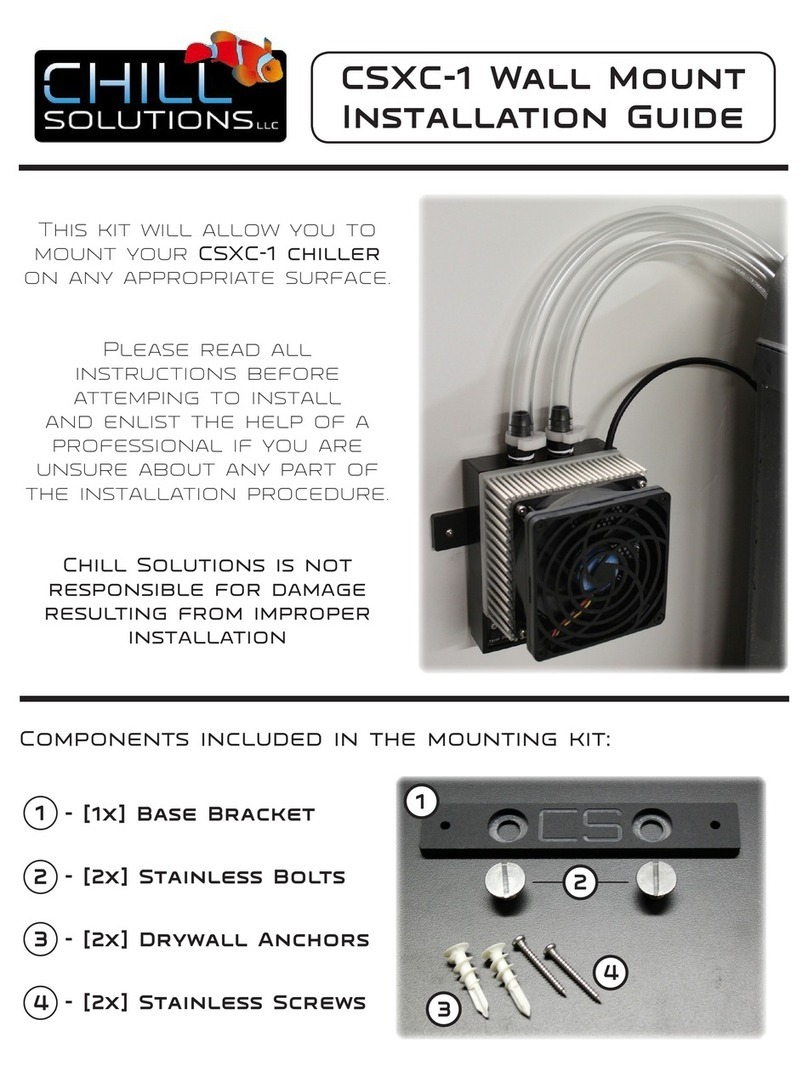
Chill Solutions
Chill Solutions CSXC-1 installation guide
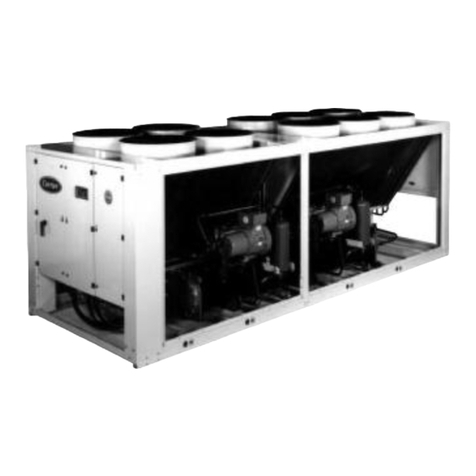
Carrier
Carrier 30GX080-265 user manual

Carrier
Carrier OPEN-DRIVE CENTRIFUGAL LIQUID CHILLERS 17CB Start-up instructions

York
York YCAS0250 Wiring diagram

Instanta
Instanta UCCH1000 INSTALLATION INFORMATION & USER INSTRUCTIONS
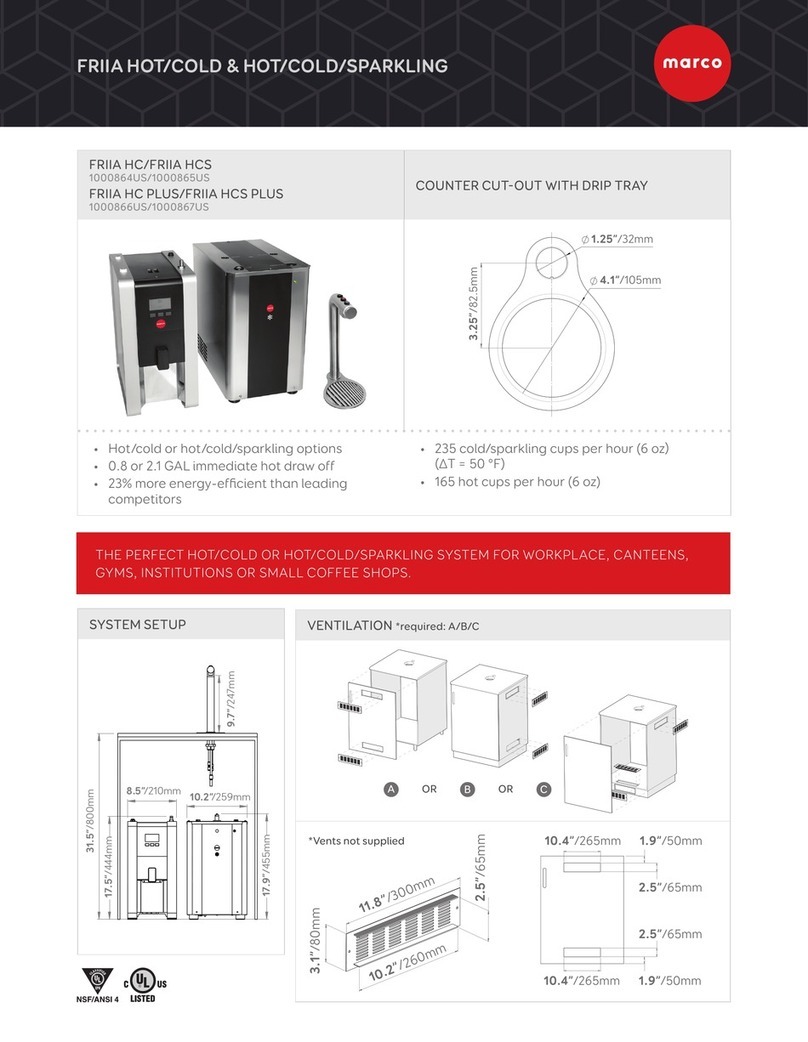
Marco
Marco FRIIA HC quick start guide
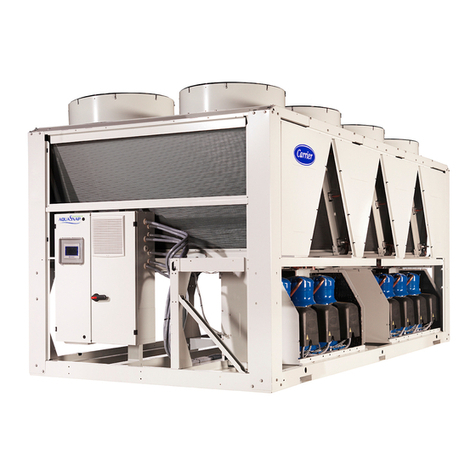
Carrier
Carrier AQUASNAP 30RBM Series Installation, operation and maintenance instructions
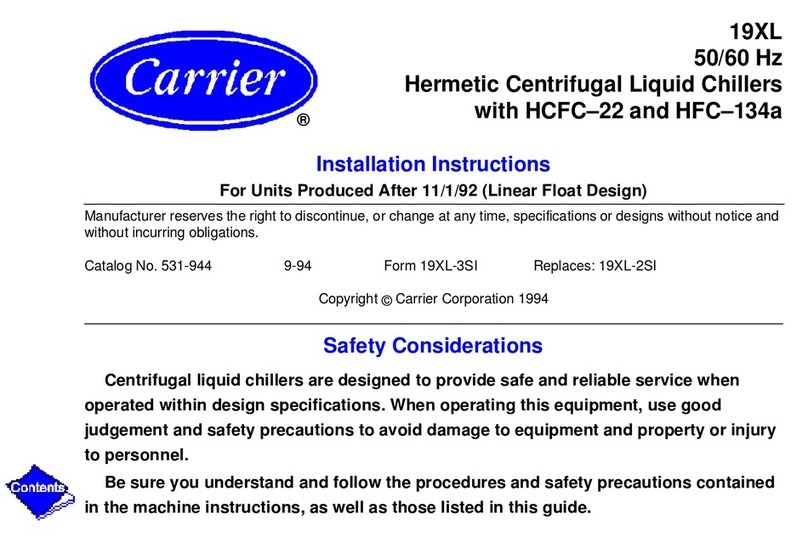
Carrier
Carrier 19XL series installation instructions

CombiSteel
CombiSteel VBL-5 user manual
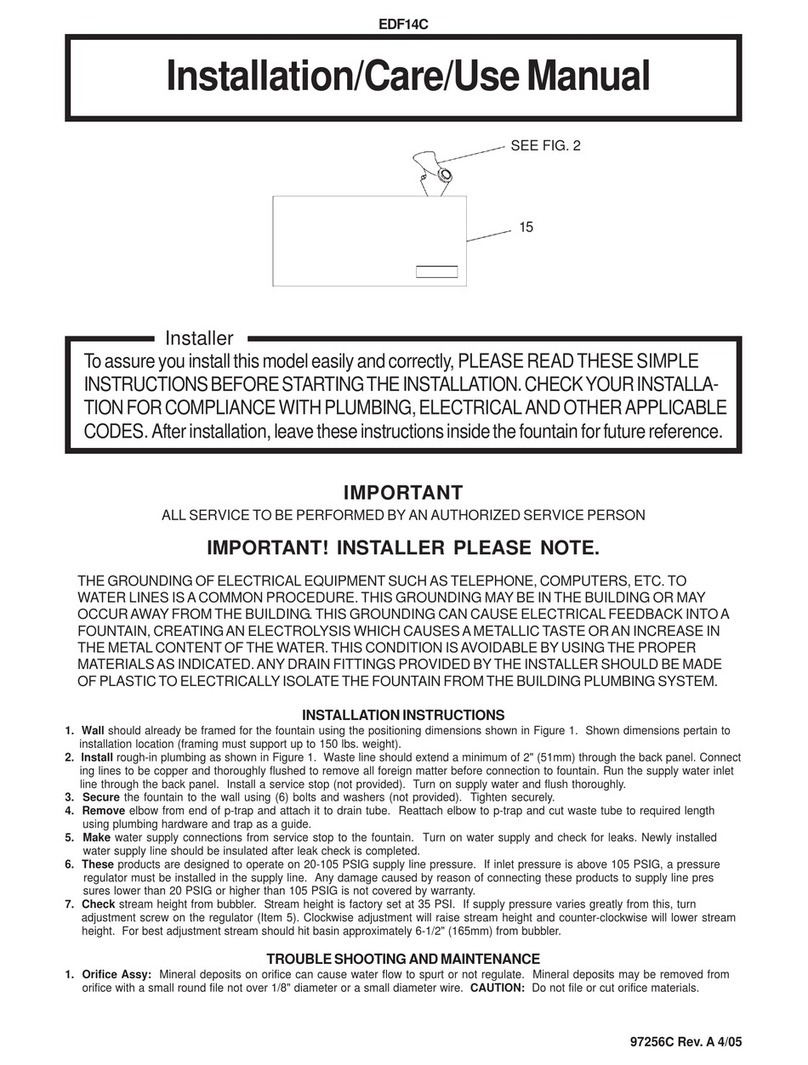
Elkay
Elkay EDF14C Installation, care & use manual

Daikin
Daikin EWAQ009ACV3 Operation manual
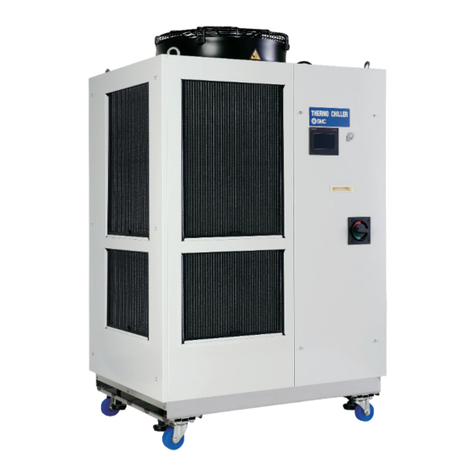
SMC Networks
SMC Networks HRL100-A*-20 Series Operation manual
